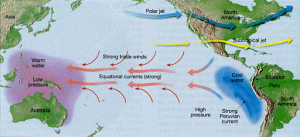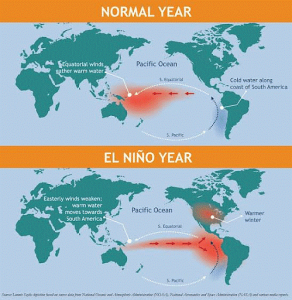Prelims – 29th Nov 23
El-Nino
El Nino is a weather phenomenon that describes the anomalous warming of surface waters in the eastern tropical Pacific Ocean. It happens more often than La Nina.
Concept behind El-Nino
- El Nino was first identified off the coast of Peru by Peruvian fishermen as the appearance of unusually warm water.
- The Spanish immigrants dubbed it El Nino, which translates as “the little boy” in Spanish.
- El Nino quickly evolved to be used to indicate erratic and extreme climatic changes rather than only the warming of coastal surface waters.
- El Nino events are not a regular cycle; they are unpredictable and occur at two- to seven-year intervals.
- Climate scientists discovered that El Nino occurs together with the Southern Oscillation.
- The Southern Oscillation is a shift in atmospheric pressure across the tropical Pacific Ocean.
- When the eastern tropical Pacific’s coastal waters warm (El Nino), the air pressure over the ocean falls.
- Climatologists refer to these interconnected processes as the El Nino-Southern Oscillation (ENSO).

El-Niño – Formation
- During an El Nino year, air pressure falls across broad regions of the central Pacific and along the South American coast.
- In the western Pacific, a weak high replaces the regular low-pressure system.
- Weak Walker Cell trade winds are diminished as a result of this shift in pressure pattern. Walker Cell can even be reversed at times.
- This decrease permits the equatorial counter current (current through the doldrums) to amass warm ocean water along the Peruvian and Ecuadorian coasts.
- The concentration of warm water causes the thermocline in the eastern Pacific Ocean to descend, cutting off the upwelling of cold deep ocean water near Peru’s coast.
- El Nino weather patterns bring dryness to the western Pacific, rain to South America’s equatorial coast, and convective storms and hurricanes to the central Pacific.

El Nino – Impact
- El Nino also has an effect on ocean temperatures, the speed and strength of ocean currents, the health of coastal fisheries, and local weather patterns from Australia to South America and beyond.
- Increased precipitation is caused by convection above warmer surface waters.
- Rainfall in South America is increasing dramatically, contributing to coastal floods and erosion.
- Diseases thrive in areas that have been ravaged by natural disasters such as flooding or drought.
- In some regions of the world, El Nino-related flooding has been linked to a rise in cholera, dengue fever, and malaria, whilst dryness can cause wildfires that cause respiratory difficulties.
- El Nino, which gives rain to South America, also causes dryness in Indonesia and Australia.
- As reservoirs dry up and rivers transport less water, the region’s water resources are jeopardized. Agriculture, which relies on water for irrigation, is also in jeopardy.
- Warm surface water is pushed westward by these winds, where it meets Asia and Australia.
- Due to the mild trade winds, the sea surface in Indonesia is typically 0.5 meters higher and 4-5° F warmer than in Ecuador.
- Warmer seas migrate westward, causing colder waters to rise to the surface off the shores of Ecuador, Peru, and Chile. This is referred to as upwelling.
- Upwelling transports cold, nutrient-rich water to the euphotic zone, the ocean’s top layer.
- It can also have a beneficial effect; for example, El Nino lessens the frequency of hurricanes in the Atlantic.
El Nino – Impacts on India
- El Nino and the Indian monsoon have an inverse relationship.
- Since 1871, the most notable droughts in India — six of them – have been El Nino droughts, including the most recent ones in 2002 and 2009.
- However, not all El Nino’s years in India resulted in a drought. For example, although 1997/98 was a significant El Nino year, there was no drought. It is due to the Indian Ocean Dipole.
- A mild El Nino in 2002, on the other hand, resulted in one of the worst droughts on record.
- El Nino has a direct influence on India’s agricultural sector since it reduces the output of summer crops such as rice, sugarcane, cotton, and oilseeds.
- The ultimate impact is apparent in the form of high inflation and low GDP growth, as agriculture accounts for around 14% of the Indian economy.
El Nino – Previous Events
- The El Nino occurrences of 1982-1983 and 1997-1998 were the most severe of the twentieth century.
- During the 1982-83 episode, sea surface temperatures in the eastern tropical Pacific ranged from 9 to 18 degrees Fahrenheit above normal.
- The 1997-98 El Nino event was the first to be systematically tracked from start to finish.
- Drought conditions prevailed in Indonesia, Malaysia, and the Philippines as a result of the 1997-98 event. Heavy rainfall and flooding were reported in Peru and California.
- During “the year without a winter,” the Midwest saw record-breaking warm temperatures.
Conclusion
El Nino refers to the occurrence of warm ocean surface waters off the coasts of Ecuador and Peru. When this happens, the normal upwelling of cold, nutrient-rich deep ocean water is greatly decreased. El Nino generally happens around Christmas and lasts a few weeks to a few months. El Nino is not a regular cycle that can be predicted in the same way that ocean tides can.
Kalakkad-Mundanthurai Tiger Reserve
The Madurai Bench of the Madras High Court has issued a notice to the State in response to a public interest litigation petition. The petition calls for a directive to limit the access of outsiders and vehicles into the Kalakkad-Mundanthurai Tiger Reserve.
About Kalakkad-Mundanthurai Tiger Reserve:
- It was established as a Tiger Reserve in 1988.
- Location: It is located in the Southern Western Ghats in the Tirunelveli and Kanyakumari districts of Tamil Nadu.
- This reserve is a mixture of three main sanctuaries: Kalakad Sanctuary, Mundanthurai Sanctuary, and a part of Kanyakumari Sanctuary.
- Nestled between Kerala and Tamil Nadu, the Agastya Malai Hill Range forms the core area of the sanctuary and is part of one of the world’s 18 biodiversity hotspots.
- The reserve is also known as the “River Sanctuary”, with as many as 14 rivers originating from this Tiger Reserve.
- Terrain: Undulating with several valleys and porous rocks.
- Flora:
- It varies from thorny shrub jungles to lush evergreen forests.
- In addition to forests, savannah woodlands, and grasslands, there are tea and coffee plantations within the reserve.
- Flora: Important species include Sarcandra, Paphiopedulum, druryi, Hopea parviflora, Hopea utilis, Calophylum elatum, Cullenia exarillata, etc.
- Fauna: Tiger, leopard, rusty spotted cat, wild dog, sloth bear, elephant, gaur, sambar, spotted deer, mouse deer, Nilgiri langur, slender loris, bonnet macaque, lion tailed macaque, etc
Central Consumer Protection Authority (CCPA)
- It is a regulatory body established under the Consumer Protection Act, 2019
- Nodal Ministry: The Ministry of Consumer Affairs
Consumer Protection Act, 2019
It replaced Consumer Protection Act 1986.
Who are consumers?
- A consumer is defined as a person who buys any good or avails a service for a consideration.
- It does not include a person who obtains a good for resale or a good or service for commercial purpose.
- It covers transactions through all modes including offline, and online through electronic means, teleshopping, multi-level marketing or direct selling.
What is misleading advertisement?
MA in relation to any product or service, is “an advertisement, which
- falsely describes such product or service; or
- gives a false guarantee to, or is likely to mislead the consumers as to the nature, substance, quantity or quality of such product or service; or
- conveys an express or implied representation which, if made by the manufacturer or seller or service provider thereof, would constitute an unfair trade practice; or
- deliberately conceals important information”.
What are the Rights of consumers?
Six consumer rights have been defined in the Act, including the right to:
- right to safety,
- right to be Informed,
- right to choose,
- right to be heard,
- right to seek redressal and
- right to consumer education.
Central Consumer Protection Authority
To promote, protect and enforce consumer rights. It can order refunds, recall goods etc. It will have an investigation wing, headed by a Director General which may conduct inquiry or investigation into such violations. It can take suo moto action.
Consumer Disputes Redressal Commission
Consumer Disputes Redressal Commissions (CDRCs) is set up at the district, state, and national levels. A consumer can file a complaint with CDRCs in relation to:
- unfair or restrictive trade practices;
- defective goods or services;
- overcharging or deceptive charging; and
- the offering of goods or services for sale which may be hazardous to life and safety.
Appeals from a District CDRC will be heard by the State CDRC. Appeals from the State CDRC will be heard by the National CDRC. Final appeal will lie before the Supreme Court.
Complaints against an unfair contract can be filed with only the State and National
Jurisdiction of CDRCs
District 1 crore State 10crore National
- The New Act also introduces the concept of product liability and brings within its scope, the product manufacturer, product service provider and product seller, for any claim for compensation.
- The Act provides for punishment by a competent court for manufacture or sale of adulterant/spurious goods.
- The court may, in case of first conviction, suspend any license issued to the person for a period of up to two years, and in case of second or subsequent conviction, cancel the license.
- There will be no fee for filing cases upto 5 lakh.
Increased compensation:
- The CCPA may impose a penalty on a manufacturer or an endorser of up to Rs 10 lakh and imprisonment for up to two years for a false or misleading advertisement.
- In case of a subsequent offence, the fine may extend to Rs 50 lakh and imprisonment of up to five years.
Mediation
- The act provides for reference to mediation by Consumer Commissions wherever scope for early settlement exists and parties agree for it.
- Mediation Cells to be attached to Consumer Commissions. Mediation to be held in consumer mediation cells.
- Panel of mediators to be selected by a selection committee consisting of the President and a member of Consumer Commission.
- No appeal against settlement through mediation.
Responsibility of E-Commerce Portal
The e-commerce portals will have to set up a robust consumer redressal mechanism as part of the rules under the Consumer Protection Act, 2019.
- They will also have to mention the country of origin which are necessary for enabling the consumer to make an informed decision at the pre-purchase stage on its platform.
- The e-commerce platforms also have to acknowledge the receipt of any consumer complaint within forty-eight hours and redress the complaint within one month from the date of receipt under this Act.
- Seller cannot refuse to take back goods.
Consumer Protection Councils
It will be established at the district, state and national levels to render advise on consumer protection. To be headed by Ministry of Consumer Affairs.
